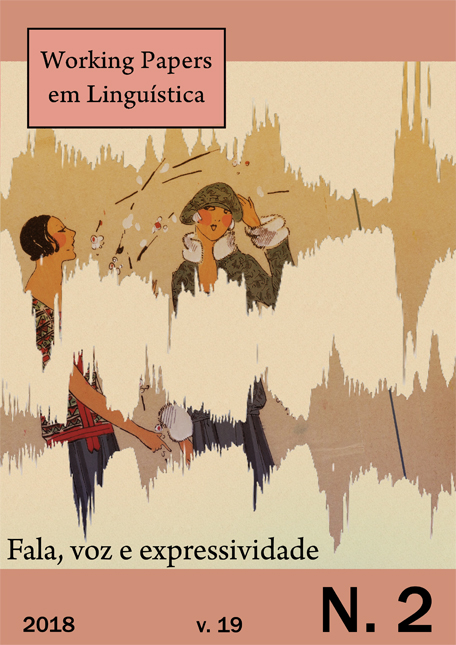O papel da fonologia do português brasileiro na tradução de textos musicais
DOI:
https://doi.org/10.5007/1984-8420.2018v19n2p78Resumen
Este estudo investiga o processo tradutológico de músicas para o canto, verificando quais estratégias o versionista lança mão para que a tradução seja tanto logocêntrica como melocêntrica quando comparada à canção original. Para esse fim, fizemos uma comparação entre a notação musical da versão original da música Seasons of Love, composta por Jonathan Larson para o teatro musical Rent em 1994, e sua versão para o português brasileiro, realizada pela versionista Mariana Elisabetsky em 2016. Com base nos aspectos da fonologia do português brasileiro, em especial ritmo, acento e os processos de juntura segmental (COLLISCHONN, 2001), nos conceitos de acento métrico e ritmo sob a perspectiva da música (BENNETT, 1987; LACERDA, 1967), e nos processos tradutológicos de músicas para o canto (FRAZON, 2008), nossa análise mostra que não é possível a realização de uma tradução literal de músicas para o canto, o que leva o versionista a criar uma adaptação para que a letra traduzida possa ser acompanhada junto à notação musical de sua letra original e, ao mesmo tempo, não cause estranhamento ao ouvinte.
Citas
BENNETT, R. Elementos Básicos da Música. Rio de Janeiro: Jorge Zahar Editor, 1987.
BENWARD, B.; SAKER, M. Music in Theory and Practice. 8. ed. New York: McGraw-Hill Education, 2009. v. 1.
BISOL, L. O Sândi e a Ressilabação. Letras de Hoje, Porto alegre, v. 31, n. 2, p. 159-168, jun. 1996.
CAGLIARI, L. C. Línguas de Ritmo Silábico. Revista de Estudos da Linguagem, Belo Horizonte, v. 20, n. 2, p. 23-58, jul./dez. 2012.
CARMO JÚNIOR, J. R. do. Sobre a Gramática da Palavra Cantada. Cadernos de Estudos Linguísticos, Campinas, v. 54, n. 2, p. 205-222, jul./dez. 2012.
CARVALHO JÚNIOR, A. D. de. Análise de padrões Musicais Rítmicos e Melódicos Utilizando o Algoritmo de Predição por Correspondência Parcial. 92p. Dissertação (Mestrado em Sistemas de Computação) – Centro de Ciências Exatas e da Natureza, Universidade Federal da Paraíba, João Pessoa, 2011.
COLLISCHONN, G. O acento em Português. In: BISOL, L. Introdução a estudos de fonologia do português brasileiro. 3. ed. Porto Alegre: EDIPUCRS, 2001, p. 125-131.
FRAZON, J. Choices in Song Translation. The Translator, London, v. 14, n. 2, p. 373-399, out. 2008.
HASTY, C. F. Meter as Rhythm. New York: Oxford University Press, 1997.
LACERDA, O. Compêndio de Teoria Elementar da Música. 3. ed. São Paulo: Ricordi Brasileira, 1967.
LARSON, J. Rent. New York: Music Theatre International, 1994. 1 partitura, 8 p. Piano.
MED, B. Ritmo. 3. ed. Brasília: MusiMed, 1984.
MEDEIROS, B. R de. Ritmo na língua e na música: o elo possível. Música em Perspectiva, Curitiba, v. 2, n. 2, p. 45-63, out. 2009.
MIGLIORINI, L. M. de Q.; MASSINI-CAGLIARI, G. Sobre o ritmo do português brasileiro: evidências de um padrão acentual. Revista Virtual de Estudos da Linguagem, São Paulo, v. 8, n. 15, p. 310-328, 2010. Disponível em: http://hdl.handle.net/11449/124843. Acesso em: 22 fev. 2017.
NOGUEIRA, M. V. Aspectos Segmentais dos Processos de Sândi Vocálico Externo no Falar de São Paulo. 144 p. Dissertação (Mestrado em Linguística) – Departamento de Semiótica e Linguística Geral, Universidade de São Paulo, São Paulo, 2007.
SCHWARTZ, S. A New Musical Wicked. Minnesota: Hal Leonard, 2003. 2 partituras, 12 p. Piano/ Vocal.
TENANI, L. E. Domínios Prosódicos no Português. 377p. Tese (Doutorado em Linguística) – Instituto de Estudos da Linguagem, Universidade Estadual de Campinas, São Paulo, 2002.
Descargas
Publicado
Número
Sección
Licencia
Os direitos autorais de trabalhos publicados são dos autores, que cedem à Revista Working Papers em Linguística o direito de publicação, ficando sua reimpressão, total ou parcial, sujeita à autorização expressa da Comissão Editorial da revista. Deve ser consignada a fonte de publicação original. Os nomes e endereços de e-mail neste site serão usados exclusivamente para os propósitos da revista, não estando disponíveis para outros fins.
The names and email addresses entered in this journal site will be used exclusively for the stated purposes of this journal and will not be made available for any other purpose or to any other party.
Esta obra está licenciada sob licença Creative Commons - Atribuição-NãoComercial- 4.0 Internacional.


